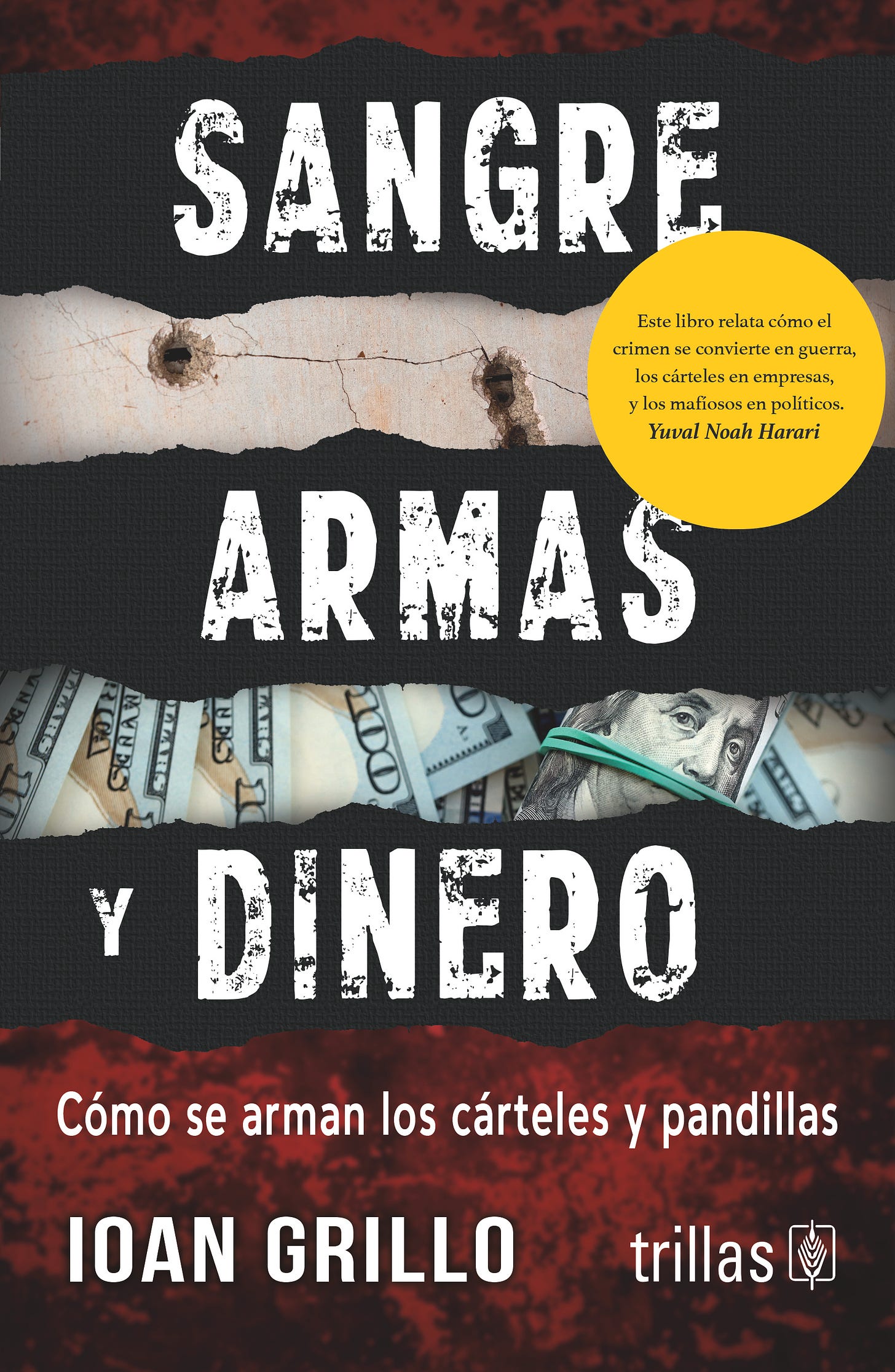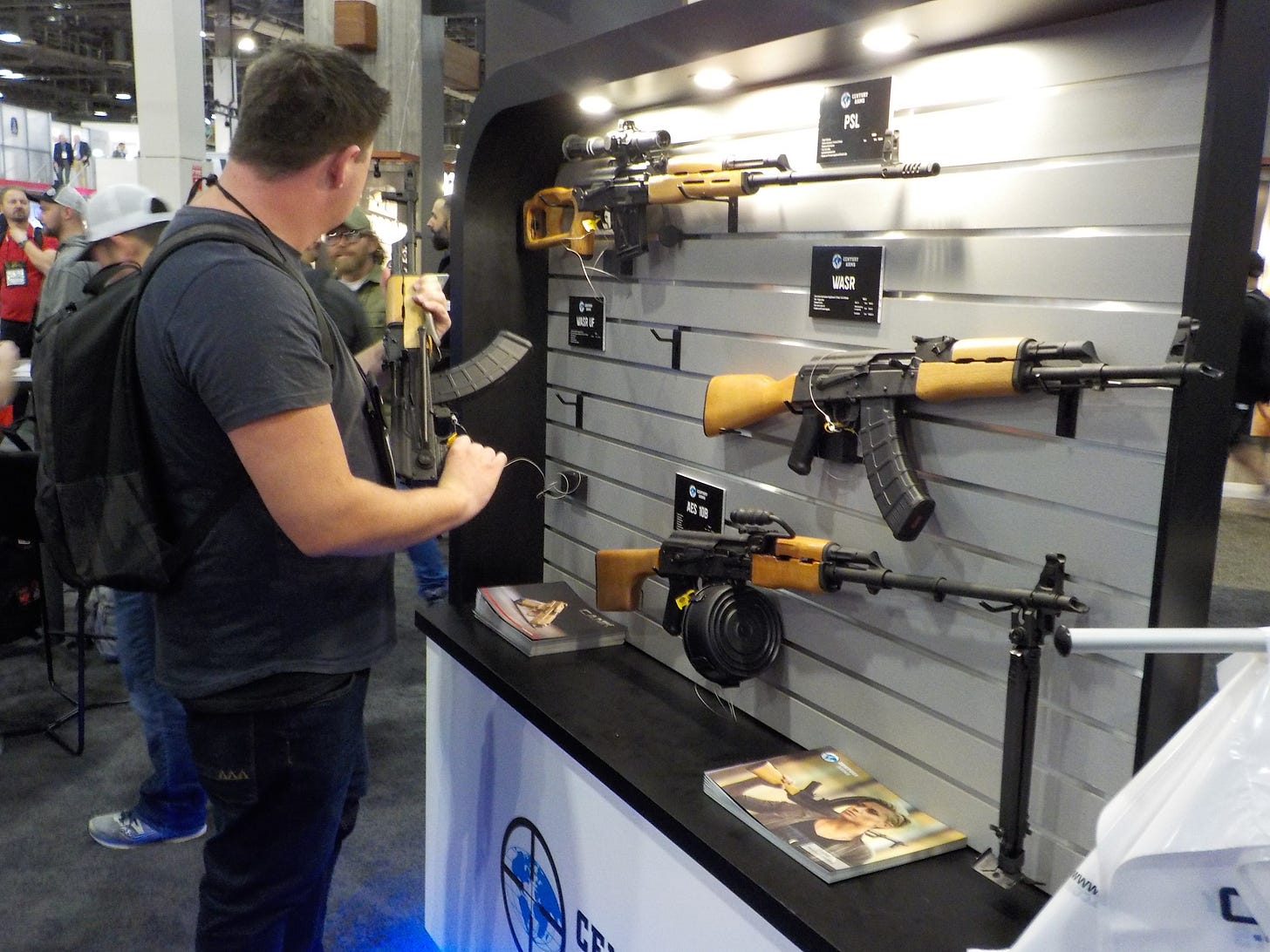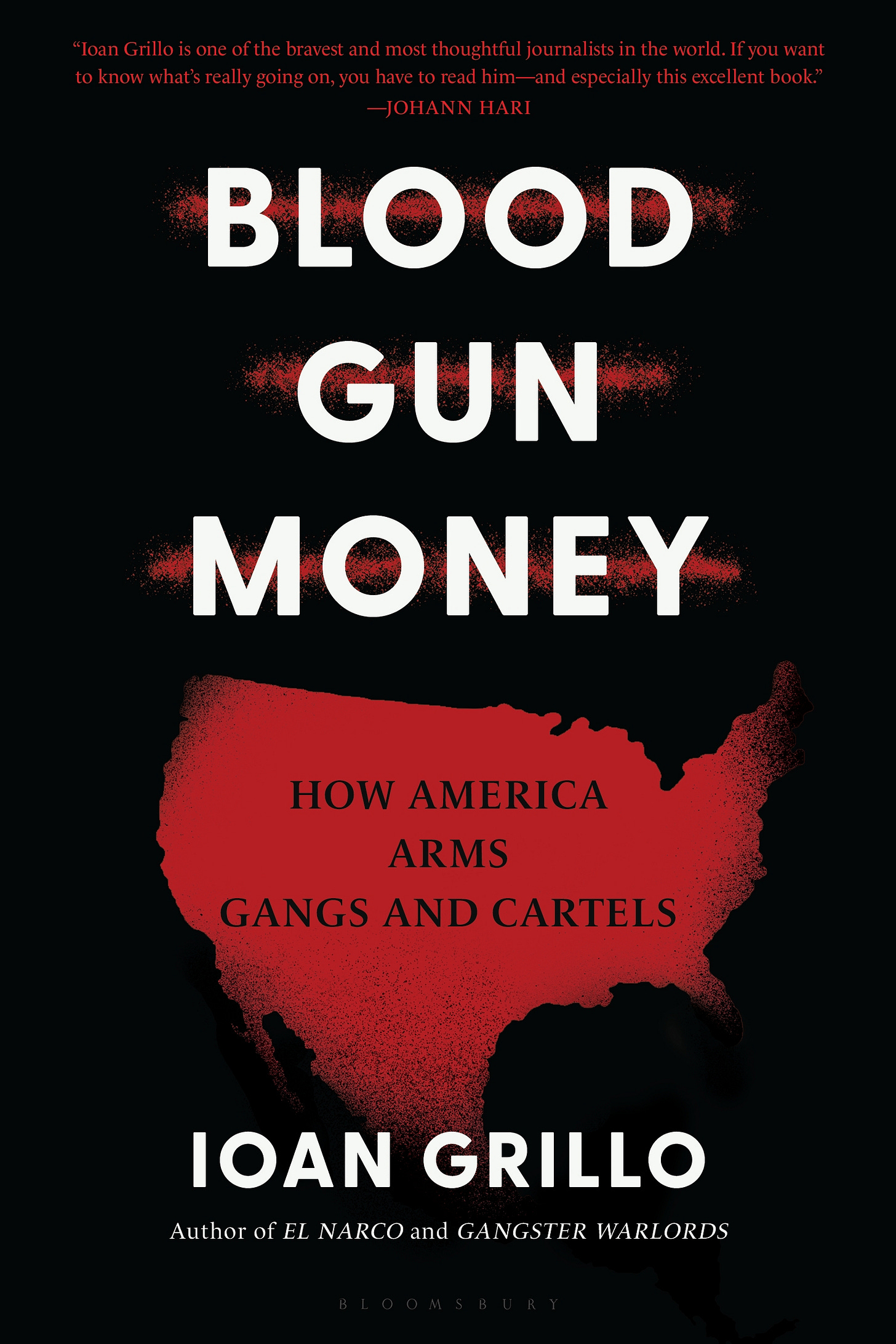Slap US Gun Runners With Terrorist Charges
Trump's designation of cartels creates a lethal weapon against arms traffickers
This is the cover of the new edition of my book, released in Spanish as Sangre Armas y Dinero, available in bookshops in Mexico and on Amazon here.
Para leer el reportaje en español, click aqui.
UPDATE - The story was updated on June 5 with the ruling by the U.S. Supreme Court against the Mexican government’s lawsuit to gun traffickers.
In August 2010, Robert Riendfliesh, a twenty-five-year-old veteran wearing a camouflage hat, walked into a pawn shop in Beaumont Texas and purchased ten brand new WASR-10 rifles (a type of Kalashnikov) that had been preordered, registering the buy in his real name. While he filled out the form to say the guns were for him, he was really acting as a “straw buyer,” and acquiring the weapons for a contact he got weed from. To pick up the AK’s, and, crucially, put his name into the background check, Riendfliesh got the princely sum of $650, or 65 bucks a gun, he said in one of his statements.
The firearms went (possibly via an intermediary) to Manuel Gomez Barba, a U.S. citizen who sold marijuana and crystal meth over in Baytown. “Manny” got dope from the fearsome Zetas cartel south of the border and he also delivered them dozens of rifles. Among the ten WASR-10’s he ran from Riendfliesh one had the serial number 1981MF8477.
The following February, a mob of Zetas in the Mexican state of San Luis Potosi attacked two U.S. agents of Immigration and Customs Enforcement or ICE. Forcing the ICE vehicle off the road, the Zetas fired into the car, killing agent Jaime Zapata and seriously wounding agent Victor Avila. The attack became an international incident, and for once, Mexican forces went after the culprits, busting a safe house with Zetas and seizing an arsenal of firepower.
Agents from the Bureau of Alcohol, Tobacco, Firearms and Explosives, or ATF, went down to Mexico to help the investigation. They took casings from the Zapata crime scene and fired weapons to compare the results. Among the matched guns was the WASR-10 with serial number 1981MF8477.
The ATF was already onto Riendfliesh and after the Zapata murder, agents swept on his home in Liberty, Texas. Riendfliesh was banged to rights and pleaded guilty. But his punishment for straw-buying a weapon used to murder an American agent was just four years probation.
Mexican cartels are armed by an iron river of guns flowing from the United States over the Rio Grande. Since 2007, more than 227,000 guns have been seized from criminals in Mexico and traced to U.S. gun shops or factories. Investigators believe this is the tip of the iceberg with one study estimating more than 200,000 guns are smuggled over the border each year. Cartels use the firepower to fight a low intensity war in Mexico that has claimed over a quarter of a million lives since 2007, and to protect routes to traffic cocaine, meth and fentanyl that have driven record overdose deaths in the United States.
In 2021, the Mexican government sued firearms companies based in the United States over the gun trafficking, alleging they were negligent and complicit. However, on June 5, the U.S. Supreme Court ruled unanimously against the lawsuit proceding to trial after the companies challenged it on grounds of jurisdiction and citing the Protection of Lawful Commerce of Arms Act.
A key way cartels acquire guns is through straw buyers, like Riendfliesh, who are usually U.S. citizens and use their clean records to pass background checks. A weakness in crackdowns was that straw buyers often only got charged with lying on the form and got no time behind bars. It was even hard to get overworked prosecutors to take the cases, said former ATF agent Steve Barborini. “They’re not going to get any jail time,” he said. “What’s the deterrent factor?”
As a result, it was easy for cartels to recruit straw buyers and pay them peanuts. One gun trafficking ring used to pay straw buyers fifty bucks a pistol, $100 per rifle (typically Kalashnikovs and AR-15s) and $500 for fifty cals that fire .50 caliber bullets that can thump through police cars. It was low reward because it was low risk, and the iron river kept flowing.
This has the potential to change drastically, however - thanks to President Donald J. Trump. Following an executive order on Trump’s first day back in office, the U.S. State Department on Feb. 20 designated six Mexican cartels as Foreign Terrorist Organizations. U.S. prosecutors can now charge straw buyers who get guns for cartels with the crime of providing material support to terrorists, which warrants a sentence of up to 20 years, or if it is directly linked to a murder, up to life imprisonment.
Prosecuting a few cases with this charge would spread fear to all straw buyers. Why risk life for a few hundred bucks? The key method of cartels acquiring weapons would be upended.
Following a memorandum from Attorney General Pam Bondi to seek the “total elimination of cartels,” prosecutors have already used terrorist charges on other cartel suspects. On May 22, an indictment charged a Utah father and son with providing terrorist support by allegedly buying stolen oil and laundering money for the Jalisco New Generation Cartel.
“Whether you are handing the cartel a gun, providing a car or safehouse for smugglers, or putting money in the cartel’s pocket, you will be held to account,” said U.S. Attorney Nicholas J. Ganjei.
It’s in the interest of the U.S. government to reduce narco firepower as more U.S. personnel cross the border to help fight cartels. While Mexican President Claudia Sheinbaum has ruled out U.S. military forces fighting directly in Mexico, special forces have gone over the Rio Grande as trainers and agents could potentially participate in field ops, as they have before.
I was originally suspicious of designating cartels as terrorists as it merges the messy war on terror with the problematic war on drugs. But now, they have done it, they should use it to cut off the cartel gun supply.
There are two caveats to this, which have been raised by gun rights advocates. The first is that the U.S. government was itself complicit in firearms trafficked to Mexico in operations such as Fast and Furious. The second is that cartels also steal weapons from Mexican security forces. I will go into these important and legitimate issues below.
Running guns versus walking guns
I spent four years investigating cartel gun running for my book Blood Gun Money: How America Arms Gangs And Cartels. It’s available in English such as on Amazon here, and this week it has come out in Spanish, available in bookshops in Mexico and on Amazon here.
As part of the investigation, I looked into the ATF’s controversial “gun walking” schemes. While criminals run guns, government agents “walk them,” or rather watch them be trafficked to gangsters with the hope they can build a conspiracy case or track them to kingpins. This may sound nuts but it follows the same logic as narcs watching drugs be sold to build a conspiracy case or even getting undercovers to help shift dope so they can bust it later.
Gun walking has been going on a long time. Carson Carroll, who was an ATF supervisor in Washington, said in an internal government email that there were agents “who have been with ATF 30 years, say they can remember a couple of attempts of a controlled delivery back in the early 80’s.”
However, it’s murky as to how much the technique was used, until a case in 2006. In Operation Wide Receiver, agents in Tucson, Arizona, watched 474 guns be sold to cartel affiliates for a total of $265,000. Years later, they had just recovered 64 of those weapons and made only underwhelming arrests.
Gun dealer Mike Detty sold AR-15s in Arizona and was a confidential informant on Wide Receiver, meeting with cartel thugs and recording his deals. He was furious how the case panned out.
“All my life I had nothing but the greatest respect for federal agents,” he wrote in his memoir of the mission. “Now, for the first time I was seeing them for what they were—lazy, sloppy, self-protecting civil servants who cared more about self-preservation and collecting a paycheck than doing the right thing.”
Despite the failure of Wide Receiver, ATF agents doubled down. In Fast and Furious, from 2009 to 2010, agents in Phoenix watched cartel straw buyers spend $1.5 million on almost 2,000 guns. The arms especially went to the Sinaloa Cartel and one was found in the last safe house of El Chapo. Again, agents never recovered most of the weapons and the arrests were of low-level players.
Fast and Furious blew up when one of the smuggled guns was used to murder Border Patrol agent Brian Terry, of the elite BORTAC unit. Whistleblowers leaked the operation to journalist Sharyl Attkisson who aired it on CBS. The case became a political fireball, leading to the U.S. lower house holding attorney general Eric Holder in contempt of Congress.
It also emerged that Mexican President Felipe Calderón knew about the op and I later interviewed him about it. “I was told the [U.S.] government was going to do something really serious about prosecuting gun traffickers. And then we started to understand there was some kind of cover operation,” Calderón said. “At that time, it sounds very good for us. But we never realized it was going to be a complete disorder.”
Fast and Furious looked so filthy that many felt that it had to be a conspiracy. In Mexico, people suspected it was a scheme to arm the Sinaloa Cartel (which had high level Mexican officials on the payroll). In the United States, the NRA claimed it was part of a plot to ban assault rifles.
Looking at the detailed communications inside the operation, however, it looks more like a major fuck up. The agents were inept rather than conspiratorial and trying to build a career case that turned into a career nightmare.
ATF whistleblower John Dodson himself comes to this conclusion. “Fast and Furious is not a grand conspiracy or cover-up—or at least it didn’t start that way,” he wrote in his account of it. “Quite the contrary, it started as an all too normal occurrence in federal government, another example of the self-licking ice-cream cone. It was the result of good people, patriotic people, smart people even, trying to get credit for the big takedown.”
So will ATF agents themselves be charged with providing guns to terrorists? It doesn’t look like it. Gunwalking was banned after Fast and Furious and it seems agents are obeying.
But the incentive to do gunwalking ops was because they couldn’t put straw buyers in jail. With the terrorist designation, they can.
There was also an important reform in the Bipartisan Safer Communities Act of 2022. A section 12004, which is entitled “Stop Illegal Trafficking in Firearms Act,” defines specific gun trafficking and straw buying crimes for the first time ever with sentences of up to 15 years. ATF agents and prosecutors also now use this, although a few terrorist charges would have a more potent public impact.
Agents have teeth to go after gun traffickers now. They just need to bite.
Guns From Mexican Soldiers?
A retort by U.S. gun rights advocates is that most cartel guns really come from the Mexican army.
Gangsters do indeed pilfer weapons from the Mexican security forces and have cops and soldiers on their payroll. But this is likely the minority of their firearms. Between 2006 and 2018, there were 15,592 guns that went missing from Mexican police or soldiers, Mexico’s defense department reported. This is significant but it is likely a fraction of cartel guns, with more than a hundred times more illegal weapons estimated to come from the United States.
Another accusation is that the Mexican government doesn’t send the serial numbers of all guns it seizes to the ATF for tracing, so it is hiding many weapons that come from the army. But this is no gotcha. Guns are seized all over Mexico including in rural police stations that don’t have access to tracing systems. Police in some backwater won’t bother to send the Mexican federal government serial numbers on a couple of pistols. Many have the serial numbers scratched off. The United States itself doesn’t trace most of the guns that its police seize.
If the Mexican army was really losing hundreds of thousands of firearms then they would not have any weapons themselves. And even while we can’t be sure of the exact percentages, we are certain that hundreds of thousands of guns have been trafficked over the border during the bloody years of the cartel wars.
I honestly try to come to this issue in a non-partisan way. I respect the U.S. Second Amendment and am not advocating it be overturned or calling for a rifle ban. But the facts show there is a historic case of trafficking to a brutal hybrid armed conflict. And it seems that it would quite doable to reduce this iron river.
Is Mexican corruption still a problem? Absolutely. Will cartels get guns from other places, like corrupt armies in South America or from further afield? Possibly. They certainly have trafficked grenades and rocket launchers from Central America.
Yet still, does the United States want to be complicit in this bloodbath? And we need to take the steps we can to reach the day, somewhere in the future, that cartels do not have such ominous power and Mexico is not drowning in bloodshed.
Photos by Ioan Grillo
Copyright Ioan Grillo and CrashOut Media 2025







There are a couple of important things to keep in mind if you want to convince Americans, particularly gun owners to go along with this. First, you need to convince law abiding citizens they have nothing to fear from this. The problem is the ATF has been completely and maliciously out of control particularly in recent years. There are several high profile cases recently where they have outright lied in court to convict innocent people and distrust and hostility towards the agency is almost unprecedented. Second, when Americans see things like piles of grenades, Warsaw Pact GPMGs, and submachine guns displayed after police raids they get suspicious and defensive. Those are obviously not coming from the US and too often it sounds like Mexican politicians are trying to shift all the blame. Finally fairly or not, not many Americans believe Mexico even cares about the drugs and migrants crossing the border.
You’re right about the gun trafficking going on for awhile. I knew people in the late 80s, early 90s when I lived down there who would haul guns that way. Getting tougher penalties might deter some people, but not nearly enough. Great piece. I’m going to reread your book. I’m sitting here looking at it now. Waiting for the next one.